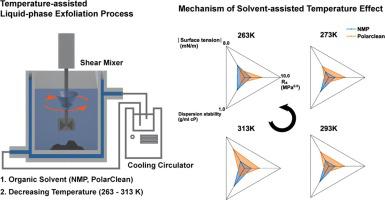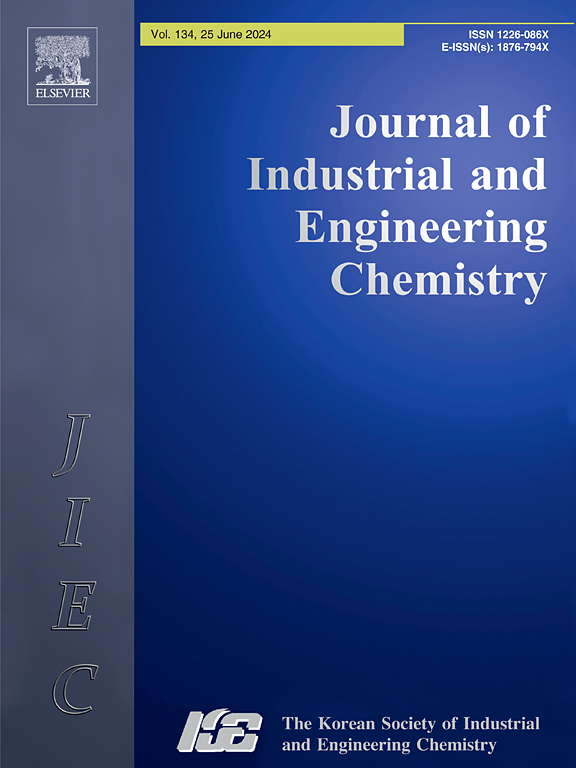Impact of solvent temperature on graphite shear exfoliation efficiency
IF 5.9
3区 工程技术
Q1 CHEMISTRY, MULTIDISCIPLINARY
Journal of Industrial and Engineering Chemistry
Pub Date : 2025-01-25
DOI:10.1016/j.jiec.2024.06.028
引用次数: 0
Abstract
Liquid phase exfoliation (LPE) of graphite is a promising pathway for graphene flakes (GF) due to its scalability and cost-effectiveness. However, the method has significant limits at the industrial scale, such as low yield of GF and long processing times. In this study, we investigate the effect of organic solvents such as N-methyl-2-pyrrolidone (NMP) and methyl-5-(dimethylamino)-2-methyl-5-oxopentanoate (PolarClean) temperature on shear-induced exfoliation. The GF concentration was successfully obtained 0.62 mg/ml in NMP and 0.68 mg/ml in PolarClean within just 2 h at 263 K, without surfactants or any additional additives. These results revealed the improved exfoliation efficiency due to changes in solvent polarity, surface tension, and dispersion stability with increased viscosity. In addition, we investigate the optimization conditions required for liter-scale shear-induced exfoliation of graphite in PolarClean. As-prepared GF has significant potential as an effective nanofiller for enhancing the mechanical strength of commercial polymers. This study not only advances the understanding of the LPE mechanisms but also paves the way for the industrial application of this method in the green synthesis of graphene-based nanocomposites.


溶剂温度对石墨剪切剥离效率的影响
石墨的液相剥离(LPE)具有可扩展性和成本效益,是一种很有前景的石墨烯薄片(GF)制备方法。然而,这种方法在工业规模上有很大的局限性,例如石墨烯产量低、处理时间长。在本研究中,我们研究了 N-甲基-2-吡咯烷酮(NMP)和 5-(二甲基氨基)-2-甲基-5-氧代戊酸甲酯(PolarClean)等有机溶剂的温度对剪切诱导剥离的影响。在 263 K 的温度下,仅用 2 小时就成功地在 NMP 和 PolarClean 中分别获得了 0.62 毫克/毫升和 0.68 毫克/毫升的 GF 浓度,且无需使用表面活性剂或任何其他添加剂。这些结果表明,随着粘度的增加,溶剂极性、表面张力和分散稳定性的变化提高了剥离效率。此外,我们还研究了在 PolarClean 中进行升规模剪切诱导石墨剥离所需的优化条件。制备的 GF 作为一种有效的纳米填料,在增强商用聚合物的机械强度方面具有巨大潜力。这项研究不仅加深了人们对 LPE 机理的理解,还为该方法在石墨烯基纳米复合材料绿色合成中的工业应用铺平了道路。
本文章由计算机程序翻译,如有差异,请以英文原文为准。
求助全文
约1分钟内获得全文
求助全文
来源期刊
CiteScore
10.40
自引率
6.60%
发文量
639
审稿时长
29 days
期刊介绍:
Journal of Industrial and Engineering Chemistry is published monthly in English by the Korean Society of Industrial and Engineering Chemistry. JIEC brings together multidisciplinary interests in one journal and is to disseminate information on all aspects of research and development in industrial and engineering chemistry. Contributions in the form of research articles, short communications, notes and reviews are considered for publication. The editors welcome original contributions that have not been and are not to be published elsewhere. Instruction to authors and a manuscript submissions form are printed at the end of each issue. Bulk reprints of individual articles can be ordered. This publication is partially supported by Korea Research Foundation and the Korean Federation of Science and Technology Societies.

 求助内容:
求助内容: 应助结果提醒方式:
应助结果提醒方式:


